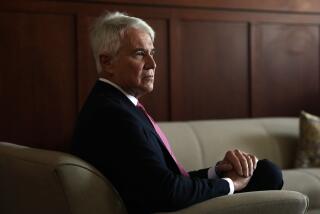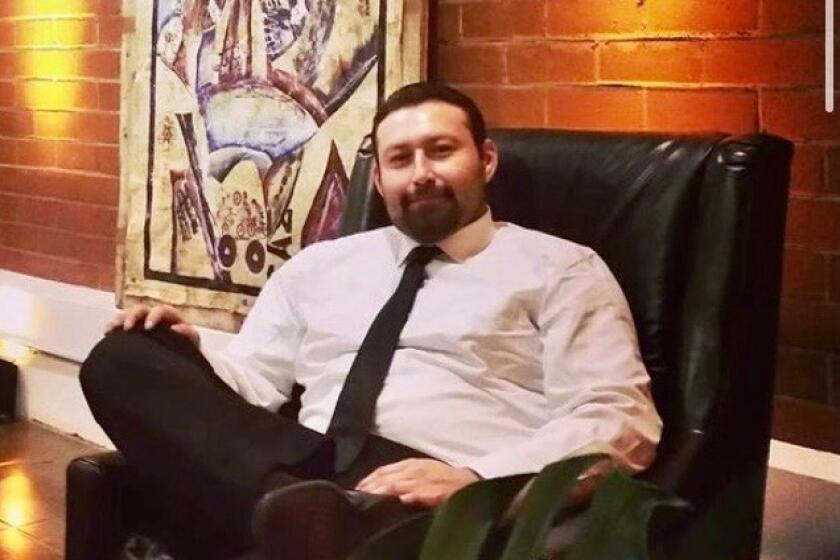Los Angeles County tries to expedite justice with fast-paced trials
Oscar Gomez was waiting to turn left onto San Pedro Street from Florence Avenue, watching cars streaming through the intersection as the light went from green to yellow to red. He was sure the driver of the black Toyota Camry, still 40 yards from the intersection, would stop.
He was wrong.
Mervad Moawad conceded in court that she drove through the intersection at the 35-mph speed limit, crashing into Gomez’s turning Ford Explorer with such force that both vehicles were totaled and she and Gomez’s year-old son were injured.
Gomez sued, accusing Moawad of negligence in the accident three years ago. A garden variety he-said, she-said standoff, the lawsuit would still be languishing on the crowded civil docket in Los Angeles County Superior Court if the two drivers hadn’t agreed to be guinea pigs last week for the state’s new expedited jury trial option.
The one-day trials are the justice system’s equivalent of speed dating. One hour for jury selection, three hours each for plaintiff and defendant to put on their cases. Only eight jurors are seated — even fewer if both sides agree — instead of the usual 12 plus alternates. There’s no need for expensive court reporter transcription because the swift and small jury’s decision is final.
The five men and three women who began deliberating Gomez vs. Moawad after just four hours of testimony came back three hours later with a verdict assigning 60% blame for the accident to Moawad. The jurors awarded Gomez $21,000 in compensation, minus 40% for his own culpability in the crash for making an unsafe turn, requiring Moawad to pay him $12,600.
The lightning trials allow parties in a conflict to agree in advance — to stipulate — to a broad range of time- and money-saving matters, such as a high-low range for the damage award that lets both sides know the worst-case outcome and avoids the possibility of a rogue jury verdict.
Expedited jury trials hold forth encouraging prospects for all involved, participants say.
Jurors can fulfill their public service in a single day — two at most.
Plaintiffs and defendants get finality, they save work days they would have to miss for longer trials and are spared the expense of expert witness testimony that can eat up much of their damage awards, especially when amounts of less than $25,000 are in dispute.
Superior Court judges, who are under the pressure of state budget cuts to do more with less, can move two or three civil cases through their courtrooms in the time it typically takes to try just one.
And lawyers can still get their Perry Mason moments, honing their argument skills in front of juries without taking on the costly accoutrements of in-person witness testimony, verbatim transcripts and 12-member juries whose expenses they have to pay in some civil cases.
The Gomez-Moawad jurors said the speedy trial option transformed their attitude toward jury service from dread to civic duty.
“The fact that it was going to be a one-day trial made me go, ‘Please, please, please pick me!’ ” said J.T. Tepnapa, a 35-year-old actor and filmmaker. “In the past I’ve spent more time trying not to be picked than I spent on this whole trial.”
Dylan Garrett, 26, works on contract in post-production television editing and would have lost money if required to serve on a longer trial.
“If you know it’s only going to be a day or two, you think, ‘That’s fine,’ ” he said. “It’s when you think it might be seven days that you start worrying how it will affect getting other stuff done.”
Jury foreman Tom Kline, a 41-year-old graphic designer, said the jurors were relaxed and willing to devote the time necessary to sort out the settlement details.
“Most jurors don’t get paid by their employers. For most it’s a cost to serve, although a cost that our society needs,” said Superior Court Judge Michael P. Linfield, who presided over the Gomez-Moawad case, the first expedited trial in Los Angeles County. For many jurors, income lost serving on a two- or three-week trial can be a serious hardship, sometimes dwarfing the amount in dispute in the case they are deciding, the judge said.
Attorney Daniel Dembicer, who represented Gomez, proclaimed the new litigation fast-track “a win-win-win situation for everyone involved,” even before the verdict that pleased his client.
“It better allocates the judicial resources. It gives the litigants a fair shake. And most of all, it’s fair to the jurors. It lets them be part of the judicial process, but they can get in and get out quickly,” he said, estimating that at least 25% of his personal injury practice would be suitable to try in the one-day format.
Michelle Katch, an attorney for Farmers Insurance representing Moawad, was more lukewarm about the prospects for clearing the civil case backlog.
“I just don’t see it being applicable to a lot of cases. This was about as simple as it gets and I’m fast, but getting everything on in a day was difficult,” she said. She noted, too, that the expedited option isn’t widely known in legal circles and that it could be more effective if the courts offered litigants some explanation of the process at the time a lawsuit is filed, as they do about alternative dispute resolution through private judging.
The attorneys, judges, court administrators and lawmakers who nursed the expedited option through the state Legislature, where it passed with a rare unanimous vote last year, have high hopes for it streamlining justice while preserving a revered institution.
“If this thing works, lawyers will actually get the opportunity to do what they went to law school for, to practice that rare art form, if not a dying one, of a jury trial,” said Paul Kiesel, a personal injury lawyer from Beverly Hills who helped shepherd the expedited option into being.
Normal trials in personal injury cases often last a week or more, and attorneys have to guess when their witnesses will be called to the stand. That can mean paying experts such as doctors more than $7,500 a day to be on hand, cutting into a successful litigant’s award money, Kiesel said. In the expedited trials, witness testimony can be submitted in writing as long as both sides agree.
As judicial officials have searched for ways to make the work of the courts more efficient, they looked to similar expedited programs in South Carolina and New York as models. In South Carolina, almost half of the civil cases taken to trial have been going the expedited route with no discernible biases in favor of either plaintiffs or defendants, said Daniel Pone, senior attorney at the California courts’ Office of Governmental Affairs.
Only a few of the lightning trials have been held since the bill took effect Jan. 1, but the pioneers mostly sing the virtues of the speedy process.
“Just do the math. As far as the court is concerned, if we can save ourselves X number of days to do each case with fewer jurors, there’s a lot of money to be saved there, and God knows that’s needed in this economic climate,” said Orange County Superior Court Judge William M. Monroe, who presided over another accident case in February.
“In 85 to 90% of cases, both sides are economically and emotionally hemorrhaging themselves by going to trial,” Monroe said.
Whether the new format catches on will depend on the personality of the attorneys involved, the judge said. “You’ll have to have counsel who are professional and not busy sticking their finger in the other guy’s eye.”
More to Read
Sign up for Essential California
The most important California stories and recommendations in your inbox every morning.
You may occasionally receive promotional content from the Los Angeles Times.










